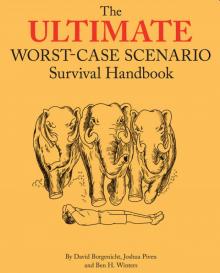- Home
- David Borgenicht
The Worst-Case Scenario Ultimate Adventure Novel: Deadly Seas Page 9
The Worst-Case Scenario Ultimate Adventure Novel: Deadly Seas Read online
Page 9
No one hears you.
The storm is overhead. The waves churn in the wind. The rain beats down on you.
You try to tread water calmly. But it’s hard to stay on top of the waves in the storm.
They’ll keep searching, you tell yourself. They’ll keep searching until they find me.
We’re so close to home. So close to winning, you think. How could this have happened? You’ve been at sea for over eight months. You’re about three weeks away from sailing victoriously into port and claiming the prize.
“I’m over here!” you yell out, frustrated and frightened.
But no one can hear you over the gusting wind.
You don’t want to drown. Conserve your strength, you tell yourself.
Your shoes are weighing you down. You kick them off. The waves pound you. It’s time to make a flotation device.
You struggle to keep your head above water as you wriggle out of your pants. You tie each leg with a double knot. Then you swing the pants over your head to fill them with air.
You tie off the waist—and you have it—a life preserver! Your pants help keep you afloat in the stormy sea.
A bolt of lightning knifes the sky. You’ve never been this scared in your life.
But the storm starts to pass. Your panic eases. Everything is going to be okay, you think.
Then you feel it.
The fin of a fish—a big fish—swipes your bare legs. Your heart begins hammering in your chest.
The boat turns around. It’s headed in your direction.
The fin brushes against your bare feet now.
Hurry! you think. Please, hurry!
You wave like crazy, trying to get the crew’s attention.
“We see you!” they all wave back and shout.
“Hurry! Shark!” you holler.
They work furiously, unfurling the sails. Getting to you as quickly as possible.
The fish bumps you. Taunts you.
The boat is here. David throws you a life preserver and a rope. As you struggle to get onboard, the fish leaps out of the water after you. You gasp.
Georgina watches, wide-eyed—and laughs.
It’s a dolphin.
“Dolphins are good luck,” she says. “Did you know that?”
“I do now,” you say.
The sun shines in the crystal-blue cloudless sky. The breeze fills the sails of the Chronos II as she skips over the waves up the California coast.
It’s day 284 of your journey. Two-and-a-half weeks ago you were nearly dead in the water. But you’re here.
You made it.
In less than one hour, you will sail into the same port you left more than nine months ago. You can’t wait to see your family. You are so proud of what you and your crewmates have accomplished. You sailed around the world—and lived to tell the tale!
As the boat enters the harbor, you can’t believe what you see.
You make your way to the stage set up for your arrival. The crowd crushes you with hugs.
Jules Houseman Jr. greets you on stage and takes the microphone. “You are all exceptional, and I am so proud of your incredible accomplishment.” He smiles broadly, congratulating each of you with a handshake and an envelope containing your prize money.
You know that your envelope is empty, but you take it anyway and smile. “Thank you, Uncle Jules,” you say.
“Uncle Jules?” Brandon says. The other crew members glare at you in shock.
“I passed the same test you did to sail on the Chronos II, but I thought if you knew who I was, you wouldn’t treat me like one of the crew,” you explain.
You didn’t take this challenge for the money, you took it to sail and conquer the sea. And the crew will forgive you when they realize you’ve given them your share of the prize.
Right now, there are smiles all around because you all earned the right to say you sailed the deadly seas—and won!
CONGRATULATIONS! YOU’VE ACHIEVED…
THE ULTIMATE SUCCESS
THE END
“It’s difficult to sail through fog without radar, but let’s keep going. We took Cape Horn to save time,” Jason reminds everyone. “We shouldn’t stop now.”
Jason carefully, slowly navigates the boat with Brandon’s help. Below, David works on getting the navigation equipment back online. The rest of you are on lookout duty.
The fog is icy and it makes you shiver. You try to peer through it, searching for nearby obstacles, the hint of a rock or the shadow of another boat. You don’t see anything, but you know you can’t trust your eyes. An object could be right in front of you—but in this fog, invisible at the same time.
You can’t trust your ears either. Fog has a funny way of bending sound so you can’t tell where a noise or a voice is coming from. If your VHF radio were working, you’d be monitoring vessel traffic and reporting on your own position to the nearby boats. But David is still working on a fix. He can’t figure out why all your equipment went down at once. In the meantime, the best you can do is sound your foghorn to warn other boats that you’re here.
The Chronos II snakes through the sharp rocks along the shoreline. It’s amazing that Jason can maintain this kind of control over the boat, you’re thinking—and then it happens. You hear a sickening squeal.
“What’s that?” Georgina cries out as a strong jolt sends her flying right into you.
“We’ve hit bottom,” you say.
The yacht has run aground along the shore of a deserted island. You get out to see where, exactly, you’ve landed, and you realize that you’re stuck—but not alone.
A group of Magellanic penguins and a colony of seals welcome you to your new home. Be nice to them—you’ll be rescued, but not for a long, long time.
THE END
“Go down below,” you tell Brandon. He listens to your advice.
You grip the mast as the rain pummels you and the waves crash onto the deck. The Chronos II swirls around the same way your plastic boats used to when the bathtub drain was unplugged.
Down below, Brandon’s stomach is swirling, too. He soon returns, and you gape at the color of his face. It is a terrible sickly green. He races to the edge and barfs. Brandon clutches the rail, but each crashing wave nearly sends him flying.
It takes every ounce of energy for you to keep on your feet. Your knuckles are white from the iron grip you have on the mast. The next wave pitches the boat nearly sideways. You scream as Brandon, not hooked into his safety harness, is swept into the churning ocean. The pounding waves drown out your cries.
Brandon is gone. Now your stomach churns, too. Losing your crewmate is enough to make the heartiest sailor sick.
THE END
“There’s a small cove,” Jason says, pointing out a place to drop anchor for the night. “By tomorrow afternoon, the fog should lift, and we’ll be able to find our way out of this maze.”
“And maybe our navigation equipment will be back online,” Chelsea says, glancing at David.
“I’m working on it,” David says, “but I’m not having much luck yet.”
You drop anchor, and everyone tries to relax a little. It’s hard to unwind. Even in the cove, huge waves rock the boat, and the wind never stops blowing. After dinner, David suggests a game of Scrabble. He takes out the board game and makes the first word—GHOST.
Georgina shudders. “I was just thinking about ghosts,” she says. “Do you think Cape Horn is haunted by the ghosts of the sailors who died here?”
“Only on foggy nights,” Brandon says.
“Only on foggy nights?” Georgina repeats.
“Yes,” Brandon says. “They rise from their watery graves because they know they can hide in the mist. Then they wait for a passing ship. They sneak on board, kill the crew, and take over the boat.”
“Really?” Now there’s a tremble in Georgina’s voice.
“No. Not really,” Jason says. “Brandon is making this stuff up.”
“Hey, you never know.” Brandon shrugs
his shoulders.
“I don’t believe in gho—” Chelsea starts, but stops at the sound of an eerie howl outside.
“It’s just the wind,” you say, but a shiver runs down your spine.
The boat starts to rock hard, much harder than before. And the wind is really gusting now. Something is definitely not right.
“I think someone should go up on deck and check things out,” David says.
You and Jason stand at the same time. “We’ll both go,” Jason says. He climbs on deck first. “Oh, no!” he cries out. “I don’t believe this.”
Your heart starts to pound. “What’s wrong?” you ask. But you’re on deck now and you can see for yourself. The anchor has come loose. You’ve been drifting in the violent waves toward another boat, and you are going to…CRASH!
THE END
“Let’s cook it for dinner,” Brandon says.
“I don’t know. It’s kind of weird looking,” you say.
“You’re kinda weird looking, but we kept you.” Brandon laughs. “This fish is going to taste awesome. Trust me.”
At dinner, everyone cleans their plates and talk soon turns to the next part of your journey—traveling through the Panama Canal.
“We have to watch out for crocodiles there,” David says—and Chelsea lets out a long moan.
“Did we finally find something Chelsea is afraid of?” Georgina laughs. But soon Georgina is moaning too—along with everyone else. You all feel like vomiting, your faces are strangely numb, and you’re dizzy.
“What kind of fish was that?” Jason asks.
“A brown, spiky, porcupine-y fish,” Brandon says.
“Ohhh,” Jason groans. “Don’t you know that you’re not supposed to eat a fish you can’t identify?”
Oh, well. You and the crew will have plenty of time to learn about that fish—in the hospital in Venezuela where you go to recover from food poisoning and huge disappointment. Your trip is done.
THE END
EXPEDITION FILE:
DEADLY SEAS
To: My Dream Team Crew
From: Mr. Jules Houseman Jr.
Re: The Sail Around the World
This Expedition File contains maps, diagrams, safety tips, and other life-saving information. Please review it carefully before you set sail.
You were all chosen for your remarkable seaworthy abilities, but out in the open water when the wind is gusting and the waves are breaking, preparation is extremely important. Decisions must often be made in a split second. I am relying on you to make the right ones.
I trust your team will circumnavigate the globe safely and return home winners. Good luck!
Ahoy!
Jules Houseman Jr.
President and Founder of Chronos Watch Company
CHARTING YOUR COURSE
1 The Great Barrier Reef
Longest reef in the world!
2 Torres Strait
A sailor’s nightmare! Lots of reefs, islands, and boat-mangling obstacles.
3 Cape of Good Hope
The ghost ship The Flying Dutchman haunts these waters. If you spot the phantom ship, you are headed for doom!
4 Gulf of Aden
Called “Pirate Alley.”
5 Southern Ocean
Miles and miles of open water with no land in sight! Watch out for icebergs!
6 Cape Horn
Super-dangerous seas!
Called “the sailors’ graveyard.”
THE CHRONOS II
Jules Houseman instructed his boat builders built the Chronos II. The boat you will sail on is a 40-foot racing yacht. It has a custom fiberglass hull and a carbon-fiber mast.
Boom: The horizontal pole that extends from the bottom of the mast. Adjusting the boom forward or back changes the position of the mainsail, which allows the boat to use wind power to move forward.
Deck: The outside part of the boat that you walk on.
Hull: The body of the boat.
Keel: A heavy finlike piece that sticks out from the bottom of the hull. The keel stops the boat from tipping over.
Mainsail: The larger sail.
Jib: The smaller, front sail.
Mast: The main pole that holds up the sails.
Rig: The mast, boom, and a system of wires called the “running rigging.”
Rudder: Located beneath the boat, the rudder is a flat piece of wood, fiberglass, or metal that is used to steer. The rudder is controlled with a tiller or a wheel on board the boat.
Stay: A large wire that supports the mast.
Direction on a Boat
Bow: The front part of the boat.
Stern: The back part of the boat.
Port: The left side of the boat when facing the bow.
Starboard: The right side of the boat when facing the bow.
Aft: Toward the back of the boat.
Fore: Torward the front of the boat.
Leeward: Torward the downwind side of the boat.
Below Deck
Berths: beds
Chart table: navigation area
Galley: kitchen
Head: bathroom
Saloon: the main living area
Stowage: where gear is stored
Sailing Terms
Tacking: Turning the bow of the boat through the wind so that the wind changes from one side of the boat to the other side.
Jibing: Turning the stern of the boat through the wind so that the wind changes from one side of the boat to the other side.
Nautical mile: The unit of measure for distance at sea used by all nations. It is based on the circumference of Earth. A nautical mile equals 1.85 kilometers or 1.15 miles.
Knot: The unit of measure for speed at sea. If you are traveling at a speed of 1 nautical mile per hour, you are traveling at a speed of 1 knot, which is 1.15 miles per hour on land.
Three Important Sailing Knots
Sailors use ropes (called lines) to haul sails, secure rigging, raise and lower anchors, and a variety of other jobs. Since lines must stay secure in strong winds and when wet, knowing how to tie strong knots is important. Here are three important knots you may need on your journey.
1. The Reef Knot: A reef knot is used to tie together two lines that have the same thickness. It is the perfect knot for tying, or reefi ng, the mainsail to the boom.
2. The Bowline: The bowline, sometimes called the “king of knots,” is best used when docking. The loop can be thrown over a docking post, called a bollard.
3. Round Turn and Two Half-Hitches: This knot is used to attach a line directly to a pole or a ring.
Shark Attack!
Even though shark attacks are extremely rare, you may find yourself face-to-jaws with this deadly ocean predator. Be prepared by knowing your sharks. The three types responsible for most human attacks are the great white shark, the tiger shark, and the bull shark.
How to Avoid an Attack:
Always swim with a buddy.
Don’t swim at dawn, dusk, or at night. Sharks don’t have good eyesight, so when it’s dark, you look like dinner.
Stay away from large groups of fish, seals, or sea lions. They are sharks’ favorite food.
If you cut yourself in the water, get out! Blood attracts sharks.
Sharks like shiny jewelry. It looks like fish scales to them.
If you see a shark approaching … Stay still and upright. Thrashing and splashing will excite the shark.
If the shark is zigzagging … It’s looking for angles to attack from. Back up against a reef, a boat, or go back-to-back with your swimming buddy.
If the shark is circling … Watch out! It’s about to zoom in for the attack.
If the shark takes hold of you … Fight! Giving up will not change the shark’s mind about eating you. If there is floating wood nearby or you have a snorkel, use it as a weapon. If not, use your fists. Hit the eyes, gills, or nose. They are the shark’s most sensitive parts. Many short, hard jabs are better than one big punch.
The Panama Cana
l
Before 1914, if sailors wanted to reach the Atlantic Ocean from the Pacific Ocean or vice versa, they had to sail around the tip of South America. Then the Panama Canal was built across the narrowest part of Central America. A canal is a man-made channel for water—it’s kind of like a new river where one never existed. Because the Pacific Ocean’s water level is higher than the Atlantic and the land across Panama is not level, an amazing series of artificial lakes and locks were built to raise or lower boats on their journey across.
How a lock works
1. The gates open and a boat moves in.
2. The gates close, and water is let into or out of the chamber, depending on the direction the boat’s heading. Every boat must be secured to the canal wall on both sides using four ropes so it doesn’t capsize.
3. Water levels are equalized then the boat moves out.
Fish That Will Kill You or Make You Really, Really Sick
There is no easy way to tell which fish are poisonous to eat and which fish will attack or sting you with deadly venom. Many poisonous fish are found in shallow water around reefs and lagoons. If you catch a fish you can’t identify, it’s best not to eat it, especially if it has a boxy or round body and spikes.
Puffer fish (also called blowfish, globefish or swellfish) This cute fish blows up like a spiky balloon to scare predators and is filled with a deadly poison called tetrodotoxin. If you eat a lot of this poison, it paralyzes your muscles and you will die within hours.
Lionfish If a lionfish punctures you with its sharp spines, it will inject a poison that causes intense pain, difficulty breathing, and paralysis.

 Extreme Junior Edition
Extreme Junior Edition Middle School
Middle School The Worst-Case Scenario Survival Handbook: Middle School
The Worst-Case Scenario Survival Handbook: Middle School Junior Edition Bundle
Junior Edition Bundle The Worst-Case Scenario Ultimate Adventure Novel: Deadly Seas
The Worst-Case Scenario Ultimate Adventure Novel: Deadly Seas Holidays
Holidays Ultimate Adventure Novel: Mars
Ultimate Adventure Novel: Mars Ultimate Worst-Case Scenario Survival Handbook
Ultimate Worst-Case Scenario Survival Handbook